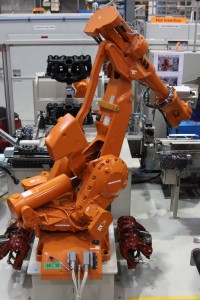 Earlier this week I had another meeting with the Federal Government. The Ministry for Industry contacted me in response to my submission on “saving Australian manufacturing”. In January the Minister for Industry invited broad input on the subject. Yes, seven months later the Department was following up on the submission.
Earlier this week I had another meeting with the Federal Government. The Ministry for Industry contacted me in response to my submission on “saving Australian manufacturing”. In January the Minister for Industry invited broad input on the subject. Yes, seven months later the Department was following up on the submission.
What did I propose? In a nutshell, I offered a model for making Australian businesses across all industries more competitive. The approach has two elements – which should and can be implemented urgently, because we are losing ground and opportunities as a country on a daily basis.
The two elements are:
1. Re-education of Australian business leaders in the Small-Medium business sector – in the foundations of competitive strategy, marketing and innovation as the only path to Productivity and Competitiveness.
This must be done on mass, reaching every business in Australia – so that we can gain critical mass fast!
2. Developing an economic and national vision for Australia – so that the Governments can plan investment in infrastructure (that includes education and skills), manage regulations and negotiate FTAs more effectively.
This includes establishing better access to massive Government knowledge resources for – not grants and handouts – but “information”: data! For example, broadly communicated export opportunities and know-how.
Without a clear economic direction (Vision) we cannot truly leverage our potential as a country and economy. Or, putting it simply, without a strategic direction for this country, we are going nowhere fast!
It is my strong belief that building business excellence in our core industries – manufacturing, agriculture, technology and tourism – is the best path to success and to a sustainable, thriving economy and a prosperous society.
That much we agree on: the importance of manufacturing.
But, the conversation started badly.
Good Riddance: “Crash and Bash” Automotive.
I was informed that the Government’s Vision for the future of Australian manufacturing is not as we know it. It is about ‘advanced manufacturing’ and not “crash and bash” industries like Automotive.
 Photo: Inside an Australian automotive.
Photo: Inside an Australian automotive.
Somewhat advanced?
Hearing this reminded me of children picking up on parents’ conversations and repeating undesirable words or statements that are potentially embarrassing for both, without understanding the real meaning. The fact is that these statements always reflect the going conversations.
So, this is the going conversation in Government circles. And, that’s the going conversation in the big corporate, top-of-the-ladder circles. Only last week Ian Smith, CEO of ANZ bank was quoted saying that the “death of car industry had to happen”.
This is pretty much what the Government representative said. Australian automotive industry was “uncompetitive because of high wages in Australia”.
Rubbish! Cars are profitably made in Germany – where wages are equally high and people get even more annual leave than we do here. On the other hand, cars are not made as profitably in the US, despite lower wages and only two weeks of holidays per year.
Digressing here, the difference is the business model and corresponding culture underpinning these two economies. German economy is built on longevity of business achieved through focus on quality and strong relationship with the customers. American economy is built on speed and marketing, pursuit of low cost at all cost; and a corporate mindset where culture of quality is not a personal value of employees.
The truth is that Australian car companies were not given a fair chance to compete in global markets. Owned by foreign corporations, they were not allowed to develop new models in line with changing market preferences (e.g. small and 4WD models), and the only Australian made 4WD, Ford Territory, was only allowed to export to one country: Thailand, because in other markets it was competing with the multinational’s other models.
The proof of Australian automotive industry competitiveness is the fact that high-end companies like BMW preferred an Australian supplier to produce their highly profitable instruments – because of quality, reliability and fast turn-around in adapting new models. However, the foreign multinational parent forced the Australian operation to ‘hand-over’ the customer to a European plant. Would this be an isolated case?
The real tragedy is that while the Federal Government is having this type of conversations (“crash and bash”), we have lost an important industry, tens of thousands of jobs, and the livelihood for many small businesses. And, it doesn’t end there. The trouble was on the cards for quite some time and no prompt effort was made to enable a transition to retain the skills in the “automotive ecosystem”. Now, unless something is done quickly, we are going to lose a generation of irreplaceable engineering knowledge and culture.
So, what do I want? I want to approach this like any business model: look at the competitive activities and find ‘adjacencies’ or other markets where these activities can be applied or transferred. And sell!
Government Picking Winners… Again!
Oh yes, we have a winner. In fact we have five winners. The Federal Government’s Vision for manufacturing is all about “high-end manufacturing” in:
- Advanced manufacturing
- Mining equipment and technologies
- Resources and Energy
- Food and Agri production (not Agriculture – that’s different)
- Pharma and Biotech
The goal is to develop these winning, big ticket industries, so we can attract ‘investment’ to Australia. What investment? Selling food manufacturing plants or farms to India and China? This kind of investment may come at a price we cannot afford as a nation. I want these countries to be our equal partners, not landlords.
The tragedy continues as creating these future industries seems to come out of thin air. Where is the skills base and the sophistication of management to support these advanced industries?
In the past eleven months we have seen a long, counter-productive dialogue, talk about policies that are being created by young people who have no industry experience or affinity with SMEs; and task forces with no sense of urgency to take action. And every day and every week this continues, we are losing skills, social values and opportunities to make this country prosperous.
I have news for you: the prosperous future for Australia is not going to be built on big multinationals; and definitely not on foreign investment in “ownership” of our assets. To have smart industry, that employs smart people, we need to have smarter and strategically better informed, if not sophisticated, SME business leaders.
Clearly, the Australian Government (and many people) does not seem to realise what we have as a country, i.e. what are the elements of our unique sustainable competitive advantage. Only then policies can be made about what and how we can defend and leverage it for our shared future. And only then we will be able to build national pride and command respect of other countries.
Our industry competitiveness is not about lower wages but ‘innovative productivity’, adding Value – achievable through understanding the basics of competitive strategy and the full potential of business innovation (there are 10 ways to innovate in addition to product R&D).
And this comes with leadership education – not MBA degrees – but basic ‘understanding’. Being informed.
Is the Government Vision for high-end industries possible?
Most of all, it’s taking too long. Nearly a year in power, and the Government is still reviewing input and establishing ‘initiatives’ – and no real action. The same chairs are being re-shuffled, the same people, who haven’t made a difference so far, are being asked for advice.
And, the ‘white elephant’ that was supposed to pull business and research together to generate economic results, turned out to be a sloth.
The failure in this area links back to the point #1 of my recommendations to the Government: need to educate leaders in SMEs. Part of the problem is that SMEs are not equipped to ask the right questions of universities. It works well for Cochlear, Kraft and other sophisticated businesses.
This is why having better informed leaders is so critical. And the Government can make it possible – at a fraction of the investment made in many other initiatives that have limited impact and no “long tail”.
If you have any doubts how the conversation ended…
I was advised that there will be more consultation and I will be added to the list to be invited to provide further input. I don’t want to provide input. I want action!
In Conclusion.
Australia has a choice: to adapt a unique Australian Business Model that is right for us and which will create a unique advantage for Australian products and services across all industries, i.e. HyperProvenance Australia. Or, we can wait for the second fleet in the form of another boom. Not in your lifetime!
The solution is so simple, it’s hidden in plain sight.
If we want to be competitive and if we want to build “advanced” manufacturing and sustainable businesses across all industries, we must reach and educate a big chunk of the 2.4 million SME business leaders in competitive business foundations – so that they can at least be better informed to seek extra professional help. And, there are plenty of smart experts in Australia, waiting to work with smart clients without the need for subsidies.
We have the technology! We can democratize the process and re-build our manufacturing and create a sustainable economy.
 InnoFuture is a specialist marketing and innovation resource for busy, under-pressure Managers. We support Business Owners and CEOs, Marketing and Innovation Managers, Sales and Operational Managers; and People & Culture Managers. We help bring your competitive strategy on everybody’s agenda, so that you can build a more productive, innovative and profitable business and take on the world and win.
InnoFuture is a specialist marketing and innovation resource for busy, under-pressure Managers. We support Business Owners and CEOs, Marketing and Innovation Managers, Sales and Operational Managers; and People & Culture Managers. We help bring your competitive strategy on everybody’s agenda, so that you can build a more productive, innovative and profitable business and take on the world and win.
Find out how to make Competitive Impact.
Contact Margaret Manson | Chief Inspirator: M: 0407 66 11 30 | P: 03 9857 9215



